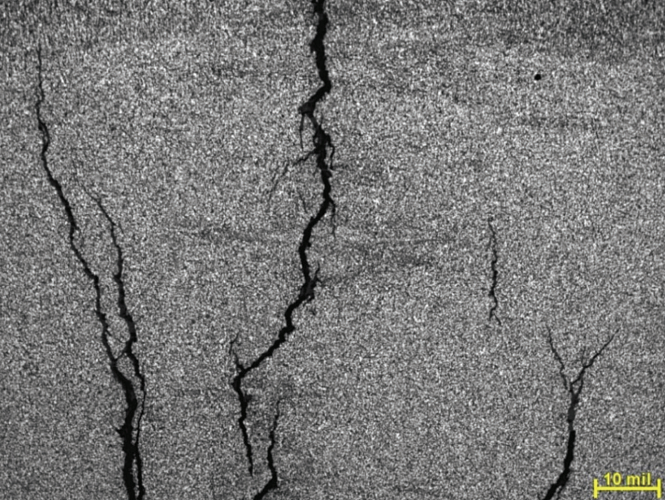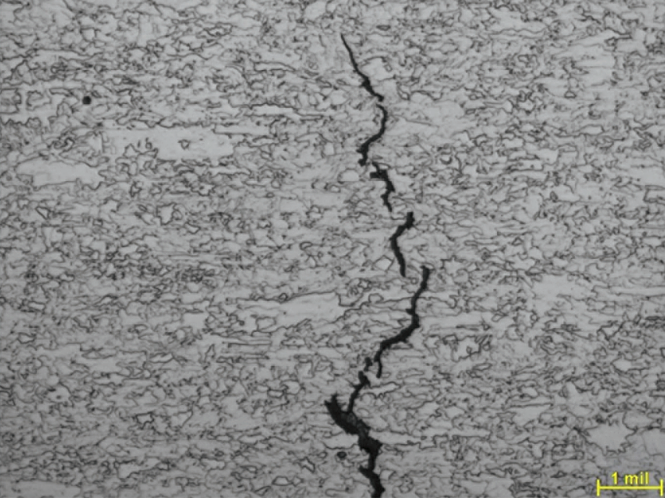Recent investigations of internal cracks associated with the butt welds in flowlines gathering wet supercritical carbon dioxide (CO2) have been found to be caused by near neutral pH stress corrosion cracking (SCC). This appears to be the first case of such internal cracking associated with a specific SCC mechanism that is widely observed and documented as external SCC on pipelines.
These findings are important to the design and operation of current and future carbon capture, including utilization and storage, projects that are or will be designed to handle wet supercritical CO2. That is, CO2 that has not been adequately dehydrated prior to handling.
Until recently, it was believed that wet carbon dioxide (CO2) could not induce stress corrosion cracking (SCC) in carbon steel (CS) equipment. However, it was recognized many years ago that in combination with other species such as carbon monoxide (CO), bicarbonate (HCO3), and carbonate (CO3), SCC could occur under certain conditions.1-2
It has been known for some time that high-strength gas cylinders containing CO2 can be susceptible to SCC.3 CO2 SCC has also been observed in relatively high-strength steels.4-5
In contrast, a large body of work has been published regarding the external SCC of relatively low-strength steel pipelines6-7 in CO2 containing environments. Depending on pH and other factors, cracking in higher pH environments is referred to as high pH SCC, while lower pH external cracking of pipelines is referred to as near neutral (NN) pH SCC.8
There is a long and successful history of transporting supercritical CO2 (SC-CO2) in bare steel pipelines when the CO2 is completely dehydrated. Until now, there have been no reported cases of internal SCC in gathering lines carrying wet SC-CO2. This article presents the initial findings from examining the internal SCC of butt welds that displayed both transverse and longitudinal cracks.
Analysis and Discussion of Internal Cracking in CO2 Pipelines
It is well known that high-pressure CO2 in the presence of liquid water can cause severe corrosion of CS equipment, especially pipelines.9
Therefore, bare CS is typically not considered for piping and pipelines in systems that handle SC-CO2 that is not dehydrated and contains a liquid water phase. In these cases, stainless steels, corrosion-resistant alloy clad pipe, and internally lined pipe are the usual materials of construction.
In the latter case the most common liner is a high-density polyethylene (HDPE) material that fits inside the steel pipe, leaving a narrow annulus between the pipe and the liner. Vents are installed at certain intervals to vent any CO2 gas entering this annular space. HDPE is known to be permeable to CO2.
Recently, several CO2 gathering lines lined with HDPE that had been operating longer than five years were found to contain transverse and longitudinal inner diameter (ID) cracks at butt welds. These lines were constructed from API 5L Grades X65 and X80 and carried SC-CO2 at a temperature of 60 °C to 71 °C (140 °F to 160 °F) and operating pressure of approximately 11.38 MPa (1650 psig). Periodically, there is water in the pipelines.
Numerous cracks were detected by nondestructive testing using phased array ultrasonic testing. Subsequently, several sections of pipe containing cracked welds were removed from the gathering lines and examined in the laboratory both nondestructively and by sectioning and metallography.
Figure 1 (top) shows several longitudinal cracks adjacent to a butt weld identified by wet magnetic particle inspection. Through a much fuller investigation, most cracks were found to be located and originated in the weld heat affected zone (HAZ) and propagated axially into the base metal with respect to the longitudinal axis of the pipe. In fewer cases, transverse cracks were found along the fusion line or just outside of the HAZ but propagating around the circumference of the pipe. In some cases, there were singular cracks but, in most cases, cracks were arrayed in colonies.

A typical cluster of axial cracks is shown in Figure 2. The cracks were predominantly transgranular with some smaller amount of intergranular fracture. In some cases, intermittent discontinuous cracks were found ahead of the main crack front, as shown in Figure 3 (below), which were generally intergranular. Most of the cracks were observed to be filled with deposits. The exact source of water for this cracking has not been determined at this time.
During the excavation and removal of pipe segments for laboratory analysis, water was found in the space between the liner and the steel pipe. Laboratory testing of numerous water samples showed the pH ranged from 5.2 to 7.1 with most values of pH 6 to 7.
The bicarbonate content was typically less than or equal to 200 ppm, and no carbonate was found. The pH was also tested using pH paper at the same time as the pipe excavation and was found to be ~6. Samples of corrosion product from this annular space were also collected and analyzed using x-ray diffraction.
The corrosion product was almost entirely iron (II) carbonate (FeCO3), which is consistent with findings of Tang and Cheng.10 It has been found that the presence of FeCO3 is promoted within confined spaces where high concentrations of ferrous ions exceeding the saturation solubility of FeCO310 are developed. The requirement of confined spaces is important to the discussion of the cracking mechanism reported in this article.
The discontinuous cracking at the tips of transgranular cracks suggested the possibility of a hydrogen contribution to the cracking. Samples from two separate pipe bodies were removed from locations of 10 in (254 mm) away from the butt welds and analyzed for total hydrogen. Both the samples found similar concentrations that averaged 3.5 ppm H2.
This is an extremely high value for hydrogen in any steel sample, but the presence of H2 is not unexpected according to Rebak et al.,11 who indicated there appears to be a contribution from hydrogen in the NN pH SCC mechanism. This would explain some of the secondary cracks away from the primary crack front. Others12 have also indicated that hydrogen plays a role in this mechanism of SCC.

The mechanical properties of all pipe samples were evaluated, and all samples complied with their respective API 5L grade requirements. The main observations of transgranular branched cracking combined with CO2 as the only species present from a corrosion standpoint plus a measured pH ~6.0 to 6.5 points to NN pH SCC as the likely mechanism. This contrasts with carbonate-bicarbonate SCC, another widely known form of cracking in the pipeline industry.
However, carbonate-bicarbonate SCC (also known as high pH SCC) requires the presence of some carbonate and a pH range of 9 to 13, contrary to pH ~6 to 7 values measured in the present cracking. Additionally, there is insufficient carbonate present under equilibrium conditions to expect carbonate-bicarbonate SCC. The crack path for carbonate-bicarbonate SCC is intergranular and that for NN pH SCC is transgranular.
Another possible cause of SCC is simply from the CO2 present in the annular space behind the liner. Little research has been performed to define the risk of SCC from CO2; however, work that has been done provides some useful information. Vancostenoble et al.13 found for low-strength annealed steel when the ratio of water volume to steel area was low CO2 would produce SCC. They measured the pH to be 6, consistent with the water pH values found in the present cracking. The small solution volume to metal surface area ratio, or confinement, allows supersaturation of ferrous iron in the small amount of water, allowing FeCO3 to precipitate and thereby establishing the conditions for SCC.
This same effect of small solution volume to metal surface area ratio was also found by Craig et. al.14 for CO2 SCC of higher-strength steels. The important point from these cited references is the small amount of water confined to a small space needed to initiate SCC.
This same confined space is also observed in external NN pH SCC under coatings that have disbonded from the pipe wall. It is important to emphasize that wet SC-CO2 transported in steel pipelines is not expected to be at risk of this form of cracking, since the very low pH of water associated with large volumes of CO2 will produce high corrosion rates that preclude the form of SCC found here.
Conclusions
The results of an investigation into the internal cracking of gathering lines transporting wet SC-CO2 indicate the most likely mechanism for cracking is from NN pH SCC, which has not been previously identified inside of steel gathering pipe.
There is apparently a necessary condition of confined spaces such as occur in lined pipe with a small annulus in order for cracking to initiate. These results should be considered speculative at this time and warrant further work to confirm the cracking mechanism.
The finding from this investigation is important as it relates to future carbon capture and storage and carbon capture utilization and storage projects that may entail the use of lined pipe to transport wet SC-CO2.